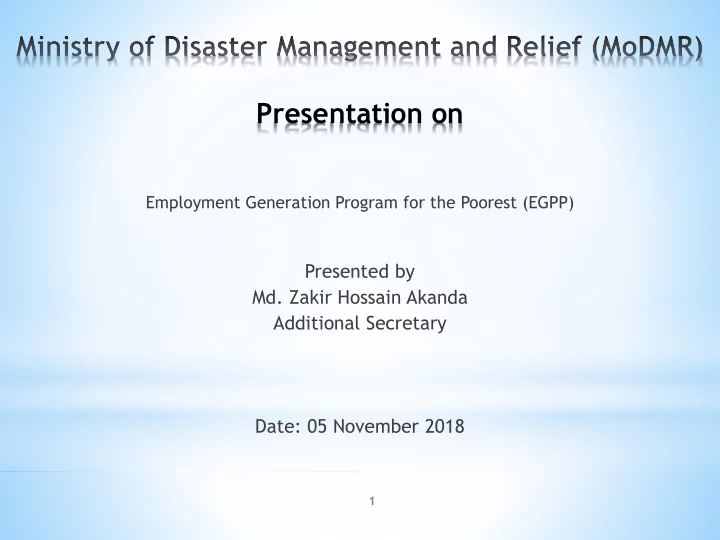

Presentation on Employment Generation Program for the Poorest (EGPP) Presented by Md. Zakir Hossain Akanda Additional Secretary Date: 05 November 2018 1
❖ Five different programs of social protection covering both cash- based and food-based program, including 3 workfare program that offers conditional transfer- EGPP , Food for work (FFW) and Test Relief (TR). ❖ Two relief programs that offer unconditional transfer- Gratuitous Relief (GR) and Vulnerable Group Geeding (VGF). ❖ Of the 3 workfare programs of MoDMR, FFW and TR programs were launched in 1975 to provide slack season employment to unemployed agricultural labours. 2
Program Type Program Allocation 2017-18 Beneficiaries (Crore taka) (Families) Workfare EGPP 1650 10,05,700 FFW 1450 (50% Solar) TR 1300 (50% Solar) Humanitarian VGF 1348.88 (3.20 Lac MT) 1,13,95,344 assistance GR (Food) 526.91 (1.25 Lac MT) 46,82,000 GR (Cash) 46.37 12,00,000 GR (House 20 1,00,000 recon.) GR 55 (12,80,000 pcs) 12,80,000 (Blanket/clo th) GR (Tin) 60 (67,662 boundle) 33,750 3
❖ EGPP is the Flagship program of GOB targeted to the most vulnerable segments of the rural poor. ❖ Employment guarantee:- Because of food price hike of 2007-2008, government had taken 100 days programs in Monga, Chars and poverty pockets areas. ❖ Employment Generation Program for the Poorest (EGPP) started from 2008-09 ❖ The short-term employment during the lean season. ❖ Two Cycle- 1 st Cycle October to December 40 days ❖ 2 nd Cycle March-April 40 Days 4
➢ to provide short-term employment to the hard-core poor in lean seasons over two cycles, and ➢ to develop rural infrastructure by constructing various projects under EGPP ➢ Provide short-term employment on community sub-projects to enable households to better cope with vulnerability. ➢ Promote women’s empowerment by ensuring a certain quota (minimum 33%) for female labour. 5
❖ EGPP members are working in the project area 6
❖ Historically EGPP owes its genesis to 100-day Employment Generation Programme (EGP). ❖ EGP for the poorest and jobless poor of AILA affected coastal districts and Monga prone districts. 7
❖ An ultra-poor person with working ability, ❖ Landless (with less than 0.5 acre land, except his house); ❖ Average monthly family income of 4000 taka or less who has no pond to fish cultivation or any countable livestock; ❖ An unskilled labor, eager but unable to find any work. ❖ Not getting concurrent assistance from other government-run safety nets programs. ❖ The share of female labour should be at 33%. ❖ The graduation of the poorest people. 8
selection of labour in a transparent manner and making cash-based payment through bank to ensure transparency. The setting of wage below market price is to attract unskilled labour who usually remain unemployed of whom mostly are women. EGPP is a new generation of safety net programmes that places extra emphasis on innovations and results while improving transparency and monitoring. 9
The evolution of EGPP , over last six years, has been captured in table following. The percentage of female beneficiaries is on continuous increase. The number of actual beneficiaries on increase so the ratio is even of greater significance. Fiscal year Budget Total number of Total number of Female beneficiaries % of allocations beneficiaries female number of beneficiaries (in lac crore) beneficiaries 2011-12 1000 622262 211214 33.93 2012-13 1200 755533 270395 35.79 2013-14 1400 773969 283685 36.65 2014-15 1500 823342 310759 37.74 2015-16 1500 824827 314468 37.89 2016-17 1650 912048 346927 38.03 10 2017-18 1650 96705 - -
Bangladesh is acclaimed globally for achieving tremendous success in poverty alleviation and its safety nets interventions with an annual outlay of 2.17% of GDP in 2017-18 11
❖ The share of women beneficiaries has always been greater than the minimum threshold (33%). ❖ Successful Payment piloting has been conducted in 08 upazilas throw bank-based digital payment with the support of a2i programme. ❖ All unions in Debidwar Upazila in Cumilla with the help of postal department. 12
❖ With The learning curve of Nilphamari and Cumilla, a bank-based digital payment piloting in eight upazila of Bangladesh with the support to a2i programme conducted. 13
➢ The most important is the wage rate (taka 200) which is much less than the prevailing market price. ➢ There should be a selection process for new set of beneficiaries to accommodate the new ground reality with emphasis on poverty-focused geographic targeting ➢ Time frame of EGPP and specific geographic requirements. ➢ Scaling up of digital payment is a big challenge ➢ Earth work done in some places by mechanized system instead of humans to be prohibited to ensure the employment generation. ➢ The practice of “forced savings” by the beneficiaries should not be discarded during the move to electronic payment ➢ NHD based beneficiary selection also is a big challenge 14
The involvement of community in the selection process of selecting project and beneficiary makes the process transparent, accountable and mostly unblemished. The strong side of EGPP is its inbuilt robust monitoring mechanism. The third party monitoring mechanism also helped EGPP to enhance its transparency and efficiency. The inclusion of a upazila level officer as Tag officer at the union level also benefitted the programme. 15
EGPP also greatly benefitted from the SNSP Project in terms of increasing administrative efficiency (employment of SAE and provisioning of laptop and other related equipment); capacity building; (organisation of training, workshop and foreign exposure visits); public Information Campaign (PIC) and third party monitoring process. 16
➢ The wage rate for EGPP beneficiaries need to be readjusted. ➢ Time frame for implementing EGPP should be more flexible to match the local weather and geographical speciality. ➢ EGPP is not required to be implemented across the country. ➢ The involvement of community, at EGPP projects, should also be reinforced to ensure social participation and ownership. ➢ EGPP should also re-examine and work out a post-SNSP project scenario for its optimal implementation ➢ EGPP program needs to continue with modification of guidelines. 17
18
Recommend
More recommend